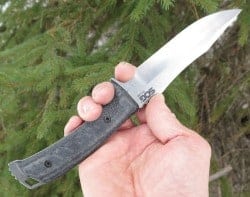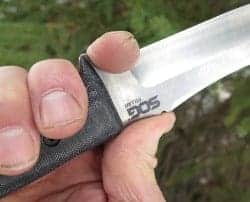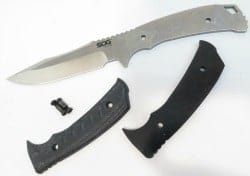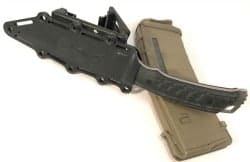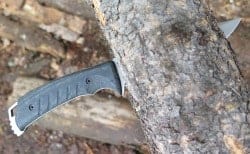| KNIFE | DETAILS | ||
|---|---|---|---|

Recommended
|
|
Check Price on Amazon.com
|
SKIP AHEAD
SOG Pillar Review
Many know SOG knives to be of good value and often of excellent performance. The Washington-based company named SOG began in 1986, but can trace its inspirational roots to special operations during the Vietnam War. The SOG Speciality Knives company began as the dream of Spencer Frazer who, as a UCLA math/science graduate, worked in the aerospace defense industry. The first SOG knife was the SOG Bowie, a commemorative nod to a fighting blade Frazer could feel was magical when he held one.
The SOG Bowie was the extent of the entire SOG knife line for a while and retailed for less than $200. And that was over 30 years ago. Sometimes events in a corporation’s history are not so much circular but spiral in quality and design while maintaining a familiar form. And thus is the case of The Pillar.
SOG began its journey into our hands with fixed blade knives and USA-based manufacturing. As time went on their designs diversified, so did their manufacturing options. In 2016, SOG had its blades and multitools manufactured in forges and tool factories in Asia. But 2017 brings some of that knife forging and construction home. So in a twist of inevitability, SOG presents a USA-made fixed blade of exceptional steel and design.
A Pillar of Society
The Pillar is the single fixed blade in the USA-made release of knives. There are three folders, all automatics, that also carry the USA pedigree. But the Pillar represents a homecoming of sorts, to the point it first caught my fancy, and then my desire, and finally my loyalty.
| KNIFE | DETAILS | ||
|---|---|---|---|

Recommended
|
|
Check Price on Amazon.com
|
Related: The Fallkniven Professional Hunting Knife
As many readers know, I have a fondness for super steels and cutting edge designs. And I am happy to say that the SOG Pillar is a knife worthy of the respect any top-shelf knife deserves, whether custom or off the assembly line.
The Pillar, and note that I choose to capitalize “The” out of respect, is a blade of the highest performance and sharpness. The Pillar is a 7.4 ounce, 10-inch masterpiece of stonewashed S35VN steel. The five and a half inch blade is all business, and the canvas Micarta scales form a near-perfect union between human hand and tool.
Downstream
The choil just forward of the index finger guard (where all choils are found) is pronounced enough for functional use, but not so deep to interfere with full blade-length cutting tasks, or large enough to impede with precision grip-close bladework. Some knives have a chasm between grip and blade causing trimming and paring work to suffer due to the leverage distance between hand and true edge. This is exactly why the sharp edge most kitchen knives begins immediately where the handle ends, and even sometimes flows back under under the grip to get a headstart on the slicing chores.
Upstream
The balance point of The Pillar is distinctly within the handle. The fore-aft flow of the knife centers just behind the index finger in a regular forehand grip. Many blades of this stature have skeletonize steel under the scales that moves the balance forward. Not The Pillar. The only absent steel out of sight under the grips are the two small holes where the fasteners bolt the Micarta scales to the blade. A balance behind the index finger makes for a very solid feel in-hand. The tradeoff of a balance-back design is found in a decreased chop force for a knife of this weight. Batoning with the The Pillar is a real treat however, especially with the plentiful flat shelf running from the midsection of the spine to the tip. But using The Pillar for such crude tasks could be viewed as an insult to the intelligence of this blade. However, that did not stop me from splitting some pine rounds with a diameter three-fourths the length of the blade.
The overall grip size of The Pillar falls somewhere between medium and small. Unlike Gerber’s blocky LMF or KaBar’s Becker series that leans on the circular, the greying canvas Micarta scales on The Pillar provide a firm handshake without making themselves the life of the party. This means they do not attract undue attention during use. Some blades have grips that consider themselves more important than the overall knife. Grips and scale must know their place in the knife dynamic. For grips and scales, serving the human hand is, as Ford says, job one.
Popular handle materials for fixed blade knives these days include good old wood and a pile of synthetics and composites including various plastics, G10, and Micarta. For the record, Micarta is a layered composite that could contain linen, canvas, paper, fiberglass, carbon fiber or other fabric which is then pressed and heated into a strong plastic that feels great in the hand. Micarta can trace its roots back to 1910 when its properties of electrical non-conductivity, temperature insensitivity, and disregard for moisture were new in such a strong material.
Rounding out the back end of The Pillar is a protruding tang with both pronounced jimping and a large diamond-shaped lanyard hole. The curved steel on the back end of The Pillar presents a viable surface upon which pressure can be applied, and even blows if absolutely necessary. But pounding on the knife might constitute abuse under the SOG Lifetime warranty, as it should.
| KNIFE | DETAILS | ||
|---|---|---|---|

Recommended
|
|
Check Price on Amazon.com
|
Steel Valor
Read Also: Swedish Steel Mora Knife
The SOG Pillar leans more towards the tactical/combat side over a survival/bushcraft blade. The Pillar has hints of that mean look we love about the SOG Seal Pup but with better steel, a more refined finish with less of the black special ops persona, and a vastly stronger handle design using scales above a solid steel frame over the Seal Pup’s glass-reinforced nylon handle. Fully enclosed handles are necessary to reduce the chance of electrocution if the blade encounters a hot wire, and also to reduce the thermal conductivity to a bare hand of hot or cold, but mostly cold.
A Sheath Done Right
Removing The Pillar from the sheath is a real treat. The highest grommet hole on the spine-side of the sheath has jimping on it and is an excellent thumb ramp allowing, the extraction of The Pillar in one clean safe move.
The Pillar and I have made several trips now and it’s still dangerously sharp. I’ve come to appreciate the handle size even more, and enjoy The Pillar’s fluid ability to slice with precision. Despite its tactical leanings, The Pillar works wood very well and shaves fire sticks with ease. The Pillar is just as comfortable working in the kitchen slicing meat and veggies as it would be, and this is just a guess, separating life from a bad guy during government sanctioned wet work.
On a more domestic tone, The Pillar is presented well in its box at point of sale. When you open the cardboard, The Pillar is floating in space centered in the rectangle. In actuality, The Pillar is secured in transparent plastic. Compare this to being stuffed in a sheath and wrapped in a piece of paper, then stuffed again in a box. Presentation of the knife might end the moment the knife goes into service, but the pride of workmanship comes across even before you touch the knife.
When it Matters
The SOG Pillar is not an ordinary knife. The Pillar can play well with the little jobs yet jump to the front line and charge into battle when things go bad. Spencer Fraser, the founder of SOG has said about his company, “We don’t settle for ordinary. “We never did, and we never will.” And The SOG Pillar proves that. Again.
| KNIFE | DETAILS | ||
|---|---|---|---|

Recommended
|
|
Check Price on Amazon.com
|


